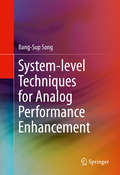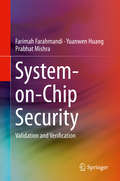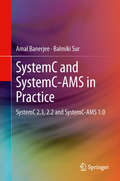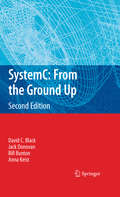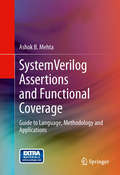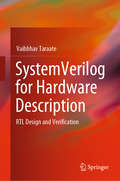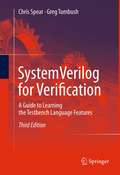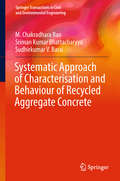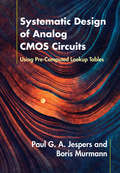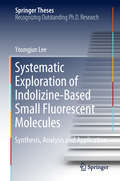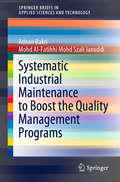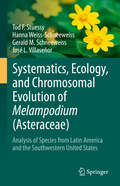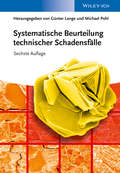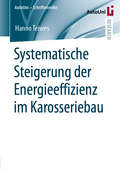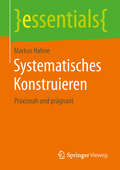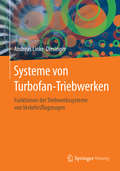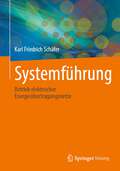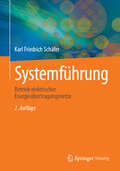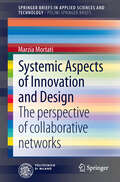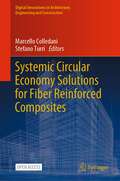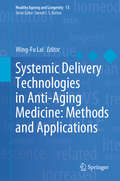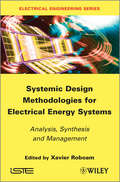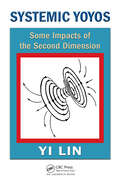- Table View
- List View
System-level Techniques for Analog Performance Enhancement
by Bang-Sup SongThis book shows readers to avoid common mistakes in circuit design, and presents classic circuit concepts and design approaches from the transistor to the system levels. The discussion is geared to be accessible and optimized for practical designers who want to learn to create circuits without simulations. Topic by topic, the author guides designers to learn the classic analog design skills by understanding the basic electronics principles correctly, and further prepares them to feel confident in designing high-performance, state-of-the art CMOS analog systems. This book combines and presents all in-depth necessary information to perform various design tasks so that readers can grasp essential material, without reading through the entire book. This top-down approach helps readers to build practical design expertise quickly, starting from their understanding of electronics fundamentals.
System-on-Chip Security: Validation and Verification
by Prabhat Mishra Farimah Farahmandi Yuanwen HuangThis book describes a wide variety of System-on-Chip (SoC) security threats and vulnerabilities, as well as their sources, in each stage of a design life cycle. The authors discuss a wide variety of state-of-the-art security verification and validation approaches such as formal methods and side-channel analysis, as well as simulation-based security and trust validation approaches. This book provides a comprehensive reference for system on chip designers and verification and validation engineers interested in verifying security and trust of heterogeneous SoCs.
SystemC and SystemC-AMS in Practice
by Amal Banerjee Balmiki SurThis book describes how engineers can make optimum use of the two industry standard analysis/design tools, SystemC and SystemC-AMS The authors use a system-level design approach, emphasizing how SystemC and SystemC-AMS features can be exploited most effectively to analyze/understand a given electronic system and explore the design space. The approach taken by this book enables system engineers to concentrate on only those SystemC/SystemC-AMS features that apply to their particular problem, leading to more efficient design. The presentation includes numerous, realistic and complete examples, which are graded in levels of difficulty to illustrate how a variety of systems can be analyzed with these tools.
SystemC: From the Ground Up, Second Edition
by David C. Black Bill Bunton Jack Donovan Anna KeistSystemC provides a robust set of extensions to the C++ language that enables rapid development of complex models of hardware and software systems. The authors focus on practical use of the language for modeling real systems, showing: A step-by-step build-up of syntax Code examples for each concept Over 8000 lines of downloadable code examples Updates to reflect the SystemC standard, IEEE 1666 Why features are as they are Many resource references How SystemC fits into an ESL methodology This new edition of an industry best seller is updated to reflect the standardization of SystemC as IEEE 1666 and other improvements that reflect feedback from readers of the first edition. The wide ranging feedback also include suggestions from editors of the Japanese and Korean language translations, professors and students, and computer engineers from a broad industrial and geographical spectrum, all who have successfully used the first edition. New chapters have been added on the SystemC Verification Library and the Transaction Level Modeling, and proposed changes to the current SystemC standard. David Black and Jack Donovan, well known consultants in the EDA industry, have teamed with Bill Bunton and Anna Keist, experienced SystemC modeling engineers, to write the second edition of this highly popular classic. As a team the authors bring over 100 years of ASIC and system design experience together to make a very readable introduction to SystemC.
SystemVerilog Assertions and Functional Coverage: Guide to Language, Methodology and Applications
by Ashok B. MehtaThis book provides a hands-on, application-oriented guide to the language and methodology of both SystemVerilog Assertions and SytemVerilog Functional Coverage. Readers will benefit from the step-by-step approach to functional hardware verification, which will enable them to uncover hidden and hard to find bugs, point directly to the source of the bug, provide for a clean and easy way to model complex timing checks and objectively answer the question 'have we functionally verified everything'. Written by a professional end-user of both SystemVerilog Assertions and SystemVerilog Functional Coverage, this book explains each concept with easy to understand examples, simulation logs and applications derived from real projects. Readers will be empowered to tackle the modeling of complex checkers for functional verification, thereby drastically reducing their time to design and debug.
SystemVerilog for Hardware Description: RTL Design and Verification
by Vaibbhav TaraateThis book introduces the reader to FPGA based design for RTL synthesis. It describes simple to complex RTL design scenarios using SystemVerilog. The book builds the story from basic fundamentals of FPGA based designs to advance RTL design and verification concepts using SystemVerilog. It provides practical information on the issues in the RTL design and verification and how to overcome these. It focuses on writing efficient RTL codes using SystemVerilog, covers design for the Xilinx FPGAs and also includes implementable code examples. The contents of this book cover improvement of design performance, assertion based verification, verification planning, and architecture and system testing using FPGAs. The book can be used for classroom teaching or as a supplement in lab work for undergraduate and graduate coursework as well as for professional development and training programs. It will also be of interest to researchers and professionals interested in the RTL design for FPGA and ASIC.
SystemVerilog for Verification
by Chris Spear Greg TumbushBased on the highly successful second edition, this extended edition of SystemVerilog for Verification: A Guide to Learning the Testbench Language Features teaches all verification features of the SystemVerilog language, providing hundreds of examples to clearly explain the concepts and basic fundamentals. It contains materials for both the full-time verification engineer and the student learning this valuable skill. In the third edition, authors Chris Spear and Greg Tumbush start with how to verify a design, and then use that context to demonstrate the language features, including the advantages and disadvantages of different styles, allowing readers to choose between alternatives. This textbook contains end-of-chapter exercises designed to enhance students' understanding of the material. Other features of this revision include: New sections on static variables, print specifiers, and DPI from the 2009 IEEE language standardDescriptions of UVM features such as factories, the test registry, and the configuration databaseExpanded code samples and explanations Numerous samples that have been tested on the major SystemVerilog simulatorsSystemVerilog for Verification: A Guide to Learning the Testbench Language Features, Third Edition is suitable for use in a one-semester SystemVerilog course on SystemVerilog at the undergraduate or graduate level. Many of the improvements to this new edition were compiled through feedback provided from hundreds of readers.
Systematic Approach of Characterisation and Behaviour of Recycled Aggregate Concrete (Springer Transactions in Civil and Environmental Engineering)
by Sudhirkumar V. Barai Sriman Kumar Bhattacharyya M. Chakradhara RaoThis book focuses on the utilisation of construction waste material as coarse aggregate in making concrete. It discusses in detail the behaviour of recycled aggregate under impact load along with other structural applications, and explains the various quality-improvement techniques for recycled aggregate and recycled aggregate concrete (RAC). The first chapter describes the importance of recycling construction and demolition waste and the status quo of global construction and demolition waste recycling. The second chapter examines the recycled aggregate production methodology. Subsequent chapters address the physical and mechanical characteristics and different research findings, as well as the engineering properties of recycled aggregate concrete. Further, the interrelationships among the mechanical properties of recycled aggregate concrete are discussed. The book also explores long-term properties like shrinkage and creep, durability properties, and microstructural characterisation. It will serve as a valuable resource for researchers and professionals alike.
Systematic Design of Analog CMOS Circuits: Using Pre-Computed Lookup Tables
by Jespers Paul G. A. Boris MurmannDiscover a fresh approach to efficient and insight-driven analog integrated circuit design in nanoscale-CMOS with this hands-on guide. Expert authors present a sizing methodology that employs SPICE-generated lookup tables, enabling close agreement between hand analysis and simulation. This enables the exploration of analog circuit tradeoffs using the gm/ID ratio as a central variable in script-based design flows, and eliminates time-consuming iterations in a circuit simulator. Supported by downloadable MATLAB code, and including over forty detailed worked examples, this book will provide professional analog circuit designers, researchers, and graduate students with the theoretical know-how and practical tools needed to acquire a systematic and re-use oriented design style for analog integrated circuits in modern CMOS.
Systematic Exploration of Indolizine-Based Small Fluorescent Molecules: Synthesis, Analysis, And Application (Springer Theses)
by Youngjun LeeThis thesis describes an in-depth study of an indolizine-based fluorophore, from understanding of its structure-photophysical property relationship to its application as a useful biological reporter.Organic fluorophores have been extensively used in the field of molecular biology owing to their excellent photophysical property, suitable cell permeability, and synthetic flexibility. Understanding of the structure-photophysical property relationship of a given fluorophore often paves the road to the development of valuable molecular probes to visualize and transcribe biological networks. In this thesis, respective chapters deal with molecular design, organic synthesis, structure-property analysis, and quantum-mechanical interpretation of unexplored family of indolizine-based molecules. This systematic exploration has led to rational development of a new microalgae lipid droplet probe, colorful bioorthogonal fluorogenic probes, and a bright mitochondrial probe, working under live cell conditions.Harnessing the optical properties of a given fluorophore has been an important topic for a couple of decades, both in industry and in academia. This thesis provides useful insights for the improvement and development of unique small fluorescent materials, or optical materials.
Systematic Industrial Maintenance to Boost the Quality Management Programs (SpringerBriefs in Applied Sciences and Technology)
by Adnan Bakri Mohd Al-Fatihhi Mohd Szali JanuddiThis book discusses the main quality management (QM) programs and their possible integration into systematic industrial maintenance (SIM). Unlike traditional engineering maintenance books, it not only explains the theory but also provides practical examples of the integration of QM and SIM programs. It also includes reference sources, making it useful for readers wanting to explore specific areas in more depth.Chapter 1 introduces various aspects of the main quality management (QM) programs, including total quality management (TQM), just-in-time (JIT) and lean manufacturing (Lean). Subsequently, it examines the relation of quality and maintenance. Chapter 2 reviews the concepts of systematic industrial maintenance (SIM) and the application of quality control (QC) tools. Chapter 3 offers an overview, historical perspective and trends in industrial maintenance techniques. Chapters 4, 5, 6, 7, 8 and 9 focus on topics related to schedule-based maintenance, condition-based maintenance, reliability-based maintenance, computerized-based maintenance, risk-based maintenance and total productive maintenance. Covering the theory of each of these types of SIM, the chapters also explain their real-world application in QM and highlight their merits and weaknesses in the context of supporting QM.
Systematics, Ecology, and Chromosomal Evolution of Melampodium (Asteraceae): Analysis of Species from Latin America and the Southwestern United States
by Tod F. Stuessy Hanna Weiss-Schneeweiss Gerald M. Schneeweiss José L. VillaseñorChromosomal change has been important in the evolution of flowering plants. Cytogenetic modifications resulting in dysploid and polyploid alterations of plant genomes have often led to the formation of new species. A genus that represents an excellent example of such changes during its evolutionary history is Melampodium (Asteraceae), occurring primarily in Mexico, Central America, and the southwestern United States. This book is a detailed presentation of the diversity of species in Melampodium, their ecological requirements and phylogenetic relationships, the biogeographic patterns and migrational pathways, chromosomal diversity, and evolutionary origins of species, especially the tetraploids and hexaploids through allopolyploidy. It is an instructive case study of evolution through chromosomal change in a broadly distributed genus of importance in the ecosystems of Mexico and adjacent regions.
Systematische Auslegung von Karosseriekonzepten hinsichtlich minimaler Umweltwirkungen in einer frühen Konzeptphase (AutoUni – Schriftenreihe #157)
by Lars ReimerWährend bei konventionell angetriebenen Fahrzeugen die Nutzungsphase maßgeblich für die Umweltwirkungen im Lebenszyklus verantwortlich ist, verlagern sich die Umweltwirkungen im Lebenszyklus eines batterieelektrisch angetriebenen Fahrzeuges in Abhängigkeit des Energiemix für das Laden in die Produktionsphase. Folglich bedarf es neben Maßnahmen zur Reduktion der Umweltwirkungen in der Nutzungsphase ebenfalls Maßnahmen zu Optimierungen in der Produktionsphase. Neben der Batteriefertigung, die etwa 46 % der Treibhausgasemissionen in der Produktionsphase verursacht, zeigt auch die Fertigung der Karosserie mit etwa 26 % ein Potential zur Reduktion der Umweltwirkungen. Daher wird eine Konstruktionsmethodik entwickelt, mit der Karosseriekonzepte hinsichtlich minimaler Umweltwirkungen und bei Gewährleistung ihrer Funktionalität und Fertigbarkeit sowie bei Berücksichtigung variierender Lebenszyklusszenarien ausgelegt werden können.
Systematische Beurteilung technischer Schadensfälle
by Michael Pohl Günter LangeZunächst stehen bei der Havarie technischer Systeme die Fragen nach Sicherheit und Kosten im Vordergrund. Aber erst durch die systematische Analyse der schadensauslösenden Mechanismen bekommt man den Schlüssel zur nachhaltigen Prophylaxe in dieHand. Das defekte Bauteil ist der ?Datenträger? für den Werkstoff und seinen Zustand sowie für die Beanspruchungen, die er erfahren hat und für den Mechanismus seines Versagens. Die Untersuchungsmethoden der Materialwissenschaft und Werkstofftechnik sind in der Lage, diese Informationen zu entschlüsseln. Durch einen Ist/Soll-Vergleich lässt sich der Schadensauslöser dingfest machen.Das vorliegende Buch ist aus einem gleichnamigen Seminar hervorgegangen. Dieses Seminar hat in mehr als 30 Jahren gezeigt, dass Schadensfälle in überwiegender Zahl auf Zuwiderhandeln gegen bekannte Regeln der Technik beruhen. Daher liegt der Fokusdieses Nachschlagewerks auf der systematischen Gliederung des Fachgebietes und der anschaulichen Erklärung der Schadensmechanismen in der Theorie sowie durch die praktische Darstellung realer Schadensfälle. Diese Kenntnisse sind für Konstrukteure und Produktionstechniker ebenso von Interesse wie für Qualitäts- und Schadensanalytiker.
Systematische Bewertung des defektdominierten Ermüdungsverhaltens der additiv gefertigten austenitischen Stähle X2CrNiMo17-12-2 und X2CrNiMo18-15-3 (Werkstofftechnische Berichte │ Reports of Materials Science and Engineering)
by Felix Julian SternFelix Julian Stern befasst sich in dieser Arbeit mit der Charakterisierung von Stählen, die mittels pulverbettbasierter Laserfusion gefertigt wurden. Von besonderer Bedeutung sind für additiv gefertigte Werkstoffe prozessbedingte Defekte wie Poren und Anbindungsfehler, die insbesondere unter Ermüdungsbeanspruchung durch ihre Kerbwirkung zu einem vorzeitigen Versagen des Werkstoffs führen. Aus diesem Grund liegt der Fokus der Untersuchungen zu einem Teil auf einer systematischen Herangehensweise zur Charakterisierung des Defekteinflusses auf die Ermüdungseigenschaften, indem Defekte mit definierter Größe, Form und Lage in einen austenitischen Chrom-Nickel-Stahl erzeugt wurden. An diesen Proben erfolgten Ermüdungsversuche, deren Ergebnisse in Kombination mit den Informationen über den künstlich eingebrachten Defekt dazu verwendet werden, zwei bruchmechanische Modelle von Murakami sowie von Shiozawa zur Beschreibung des Ermüdungsverhaltens zu validieren. Im zweiten Teil werden diese Modelle dazu genutzt, den Einfluss des Legierungselements Stickstoff in einem weiteren austenitischen Chrom-Nickel-Stahl zu untersuchen, wobei sowohl das Ermüdungsverhalten an Luft als auch in korrosivem Medium erfolgreich beschrieben wird. Diese Arbeit bietet somit Ansätze zur systematischen Bewertung des Einflusses von Defekten auf additiv gefertigte Werkstoffe und zur Beschreibung des Ermüdungsverhaltens unter korrosiver Beanspruchung.
Systematische Steigerung der Energieeffizienz im Karosseriebau (AutoUni – Schriftenreihe #150)
by Hanno TeiwesDie vorliegende Dissertation präsentiert ein Konzept zur Steigerung der Energieeffizienz im Karosseriebau um durchschnittlich 10-15%. Die dafür benötigte Energietransparenz wird durch die strukturierte energetische Analyse bestehender Karosseriebauanlagen erreicht. Weiterhin besteht bereits im Karosseriebauplanungsprozess die Möglichkeit einer Energieprognose der zu planenden Arbeitsgruppen als auch des energetischen Lastprofils. In Abhängigkeit der energetischen Bewertung werden mit Hilfe eines Expertensystems entsprechend zu ergreifende Maßnahmen dem Planer zur Verfügung gestellt.
Systematisches Konstruieren: Praxisnah und prägnant (essentials)
by Markus HahneDieses essential bietet einen theoriefreien Einblick in den faszinierenden und diffizilen Entstehungsprozess technischer Produkte, der anhand eines begleitenden Praxisbeispiels einfach nachvollzogen und bis zur ersten eigenen Maschinenkonstruktion selbst weiterentwickelt werden kann. Hierbei helfen die vorgestellten Methoden und Beispiele ebenso wie der Aufbau des essentials. Der Konstruktionsprozess wird in seinem natürlichen Verlauf nachgezeichnet. Zugleich wird das bereichsübergreifende Spektrum aller konstruktionsrelevanten Bereiche aufgezeigt sowie auf wichtige Entscheidungspunkte hingewiesen.
Systeme von Turbofan-Triebwerken: Funktionen der Triebwerkssysteme von Verkehrsflugzeugen
by Andreas Linke-DiesingerUm das Funktionsprinzip von Turbinentriebwerken zu verstehen, reicht es nicht aus, das grundsätzliche Funktionsprinzip einer Gasturbine zu kennen. Es ist ebenfalls erforderlich, die Funktionen und den Aufbau der Triebwerkssysteme zu verstehen. Dieses Buch bietet eine Einführung in die Systemfunktionen von modernen Turbofan-Triebwerken. Es ist für Leser geschrieben, die mit dem Funktionsprinzip des Turbinentriebwerks vertraut sind und sich grundlegend mit den Funktionen der Triebwerkssysteme befassen wollen. Mit Hilfe dieses Buches erhält der Leser auch eine Orientierung in dem scheinbaren Gewirr von Rohrleitungen, Schläuchen, Kabeln und Systembauteilen an einem Turbofan-Triebwerk. In diesem Buch findet der Leser Informationen über den Betrieb der Triebwerkssysteme, die Aufgaben ihrer Komponenten und die in der Luftfahrtindustrie übliche Terminologie. Die englischen Begriffe werden ebenfalls genannt oder auch im Text verwendet, wenn dies sinnvoll ist. Die Triebwerkssysteme werden anhand von Beispielen erklärt, die von heute in Verwendung befindlichen Triebwerkstypen verschiedener Hersteller stammen. Dieses Buch ist eine nützliche Informationsquelle für Mechaniker und Ingenieurs-Studenten. Auch Flugschüler in der Berufspilotenausbildung finden hier Informationen, die das in ihrer Ausbildung vermittelte Wissen erweitern. Selbst für Leser ohne Ingenieursausbildung und für solche, die sich nicht beruflich mit der Materie befassen, bietet das Buch umfassende und leicht verständliche Informationen. Es hilft ihnen, die Funktionsprinzipien der Systeme von Turbofan-Triebwerken zu verstehen.
Systemführung: Betrieb elektrischer Energieübertragungsnetze
by Karl Friedrich SchäferIn diesem Buch werden die wesentlichen Aufgaben der Systemführung von elektrischen Übertragungsnetzen beschrieben. Dazu gehören die Netzführung, die Einhaltung der Systembilanz, die Gewährleistung der Systemsicherheit und die Koordinierung des Stromhandels. Das Buch gibt einen Überblick über den Aufbau und die Struktur von Übertragungsnetzen sowie über deren geschichtliche Entwicklung. Die Einbindung der nationalen Übertragungsnetze in die europäische Verbundsystemführung und in die Sicherheitszentren ist ebenfalls Bestandteil dieses Buches. Es werden der Aufbau und die Aufgaben von Schaltleitungen beschrieben. Die künftige Entwicklung im Bereich der Systemführung wird an den Beispielen neuer Visualisierungskonzepte und kurativem Engpassmanagement skizziert.
Systemführung: Betrieb elektrischer Energieübertragungsnetze
by Karl Friedrich SchäferIn diesem Buch werden die wesentlichen Aufgaben der Systemführung von elektrischen Übertragungsnetzen beschrieben. Dazu gehören die Netzführung, die Einhaltung der Systembilanz, die Gewährleistung der Systemsicherheit und die Koordinierung des Stromhandels. Das Buch gibt einen Überblick über den Aufbau und die Struktur von Übertragungsnetzen sowie über deren geschichtliche Entwicklung. Die Einbindung der nationalen Übertragungsnetze in die europäische Verbundsystemführung und in die Sicherheitszentren ist ebenfalls Bestandteil dieses Buches. Es werden der Aufbau und die Aufgaben von Schaltleitungen beschrieben. Die künftige Entwicklung im Bereich der Systemführung wird an den Beispielen neuer Visualisierungskonzepte und kurativem Engpassmanagement skizziert.
Systemic Aspects of Innovation and Design
by Marzia MortatiThe book provides a snapshot of a hot topic - the systemic nature of innovation and its relevance to design - with a trifold perspective: the academic level - the literature on innovation studies and design is often neglected and a clear connection between the two topics taken for granted; the research level - collaborative models are currently considered great opportunities for transforming consumption, production and distribution of goods, but a clear scholarly discourse is still forming; the political level - the European Commission and the OECD are devoting much effort to understanding and measuring the impact of design in innovation processes and firms and a clear contribution would greatly support this path. Thus the book provides an informed, historical and nuanced perspective to the relationship between design and innovation to contribute to all three levels and to propose a point of view that goes beyond aesthetics and meanings.
Systemic Circular Economy Solutions for Fiber Reinforced Composites (Digital Innovations in Architecture, Engineering and Construction)
by Marcello Colledani Stefano TurriThis open access book provides an overview of the work undertaken within the FiberEUse project, which developed solutions enhancing the profitability of composite recycling and reuse in value-added products, with a cross-sectorial approach. Glass and carbon fiber reinforced polymers, or composites, are increasingly used as structural materials in many manufacturing sectors like transport, constructions and energy due to their better lightweight and corrosion resistance compared to metals. However, composite recycling is still a challenge since no significant added value in the recycling and reprocessing of composites is demonstrated. FiberEUse developed innovative solutions and business models towards sustainable Circular Economy solutions for post-use composite-made products. Three strategies are presented, namely mechanical recycling of short fibers, thermal recycling of long fibers and modular car parts design for sustainable disassembly and remanufacturing. The validation of the FiberEUse approach within eight industrial demonstrators shows the potentials towards new Circular Economy value-chains for composite materials.
Systemic Delivery Technologies in Anti-Aging Medicine: Methods and Applications (Healthy Ageing and Longevity #13)
by Wing-Fu LaiThis book presents a multidisciplinary assessment of the state of science in the use of systemic delivery technologies to deliver anti-aging therapeutics now under development. There is a gap between basic aging research and the development of intervention technologies. This major obstacle must be overcome before biogerontological interventions can be put into clinical practice. As biogerontology comes to understand aging as a systemic degenerative process, it is clear that there is a pressing need for technologies that enable cells and tissues in a fully developed adult body to be manipulated systemically to combat aging. The authors review advances in the chemistry and engineering of systemic delivery methods and analyze the strengths and limitations of each.The book is organized into six sections. The first offers an overview of the need for systemic delivery technologies alongside the development of anti-aging therapies and describes approaches that will be required for studying the properties and efficiency of carriers for systemic delivery. Sections II, III and IV describe recent advances in a range of strategies that may enable systemic delivery to help combat aging conditions ranging from cell senescence to decline in immune function and hormonal secretion. Section V discusses practical strategies to engineer and optimize the performance of delivery technologies for applications in systemic delivery, along with their working principles. The final section discusses technical and biological barriers that must be overcome as systemic delivery technologies move from research laboratory to clinical applications aimed at tackling aging and age-associated diseases.Benefiting scholars, students and a broader audience of interested readers, the book includes helpful glossary sections in each chapter, as well as sidebars that highlight important notes, and questions for future research.
Systemic Design Methodologies for Electrical Energy Systems: Analysis, Synthesis and Management
by Xavier RoboamThis book proposes systemic design methodologies applied to electrical energy systems, in particular analysis and system management, modeling and sizing tools.It includes 8 chapters: after an introduction to the systemic approach (history, basics & fundamental issues, index terms) for designing energy systems, this book presents two different graphical formalisms especially dedicated to multidisciplinary devices modeling, synthesis and analysis: Bond Graph and COG/EMR. Other systemic analysis approaches for quality and stability of systems, as well as for safety and robustness analysis tools are also proposed. One chapter is dedicated to energy management and another is focused on Monte Carlo algorithms for electrical systems and networks sizing.The aim of this book is to summarize design methodologies based in particular on a systemic viewpoint, by considering the system as a whole. These methods and tools are proposed by the most important French research laboratories, which have many scientific partnerships with other European and international research institutions. Scientists and engineers in the field of electrical engineering, especially teachers/researchers because of the focus on methodological issues, will find this book extremely useful, as will PhD and Masters students in this field.
Systemic Yoyos: Some Impacts of the Second Dimension (Systems Evaluation, Prediction, and Decision-Making)
by Yi LinA Novel Method to Analyze Problems and Encourage Systemic ThinkingReal-Life Case Studies Illustrate the Application of the Systemic Yoyo Model in Diverse AreasWritten by the co-creator of the systemic yoyo model, Systemic Yoyos: Some Impacts of the Second Dimension shows how the yoyo model and its methodology can be employed to study many unsettled
